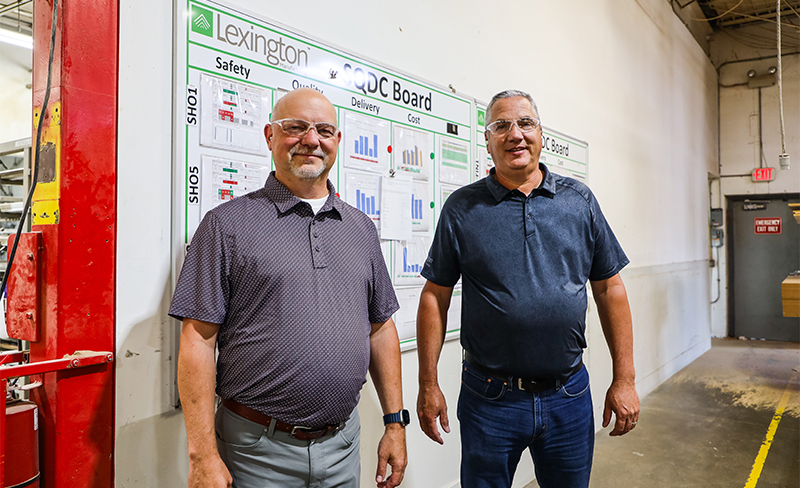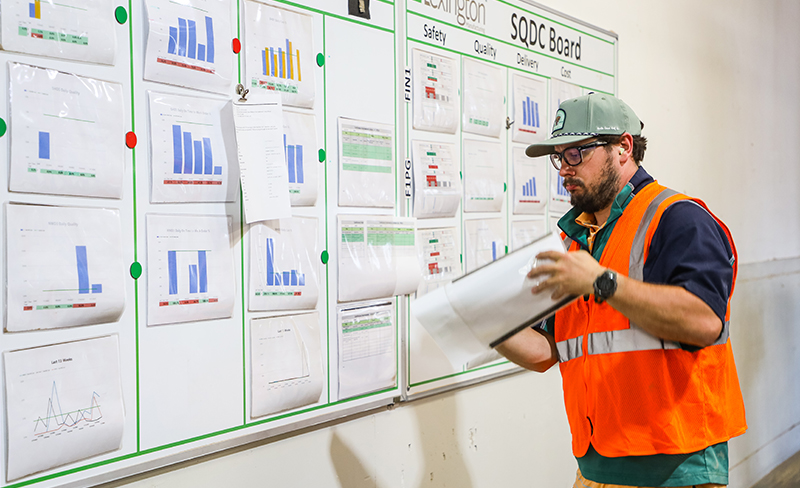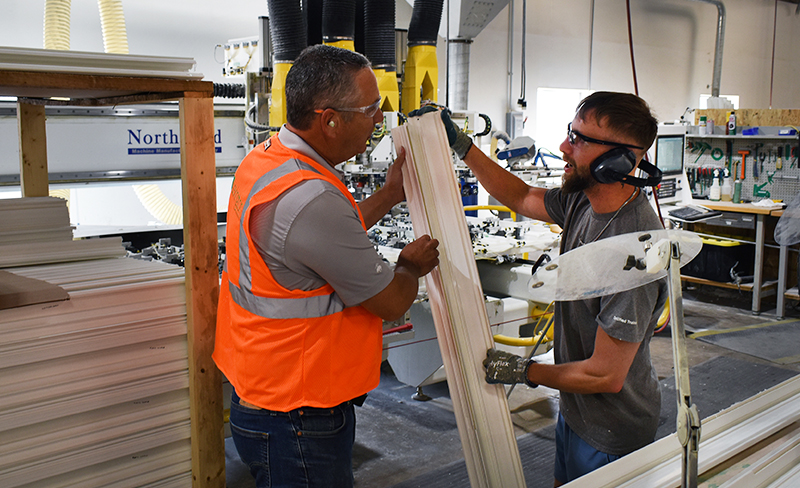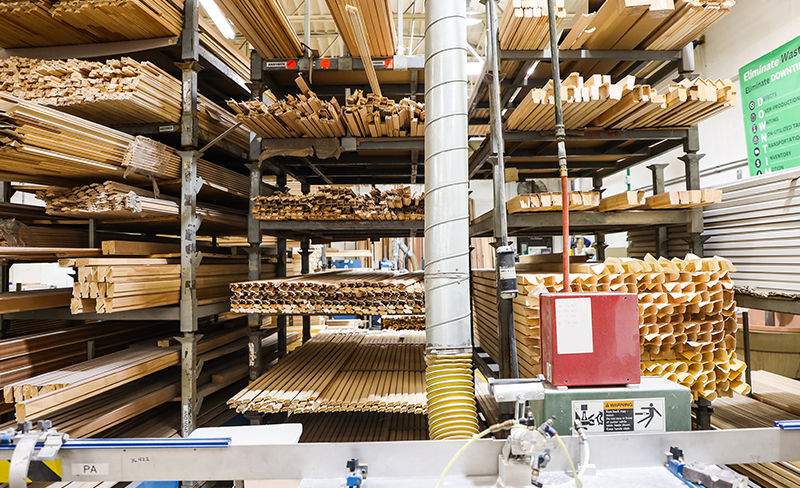Mike Dillon, president of Brainerd- and Coon Rapids-based Lexington Manufacturing, recalls the strategic planning session in which the OEM component manufacturer’s leaders realized just how big the company could grow. It was late 2018 and Lexington had annual sales of about $75 million. A dozen of the company’s leaders had camped out at a northern Minnesota resort to project sales targets for the next five and 10 years.
More than 35 years old and family owned, Lexington had a solid and growing business providing window components to a wide range of top window manufacturers as well as door components to premier commercial door brands around the country. As Lexington grew, the company developed very strong partnerships with several large OEM manufacturers. “We wanted to continue growing with them while not having any one of them exceed our comfort level for single customer concentration,” Dillon says. “We also never want to say no to our customers, so not growing with them is not an option.” Using those parameters, Dillon’s team calculated that the potential growth of well-balanced relationships could be substantial — some $200 million over 10 years.

So far, the math is on track. With sales of over $120 million in 2024, Lexington leaders believe they can hit what they call the “big hairy goal” in the next three years through a combination of disciplined HR strategies, improved processes, and prudential acquisitions.
The biggest bottleneck is people, Dillon says. “We have to get people in the business, teach them what to do, how to be leaders, and develop their technical skills.”
His passion for helping employees build skills and grow their careers is rooted in his own career path. Dillon joined Lexington right after college as a CNC operator at the Coon Rapids plant. While he had a degree in forest products management, he didn’t know anything about CNC, window components, or the business. After a year, he left Lexington for another job.
“It was a greener pastures thing,” he says, “but I decided the other side of that fence was not greener.” He was hired back in Lexington’s purchasing department one year later. When the company opened a plant in Brainerd in 1998 to make door components, he volunteered to help open it. Over the next 20 years, he went from plant manager to general manager. In 2016, when company owners Bob and John Dimke, nearing retirement, prepared the company for sale, they promoted Dillon to president. Coincidentally, they finalized the sale to Georgia-based Watkins Associated Industries during the strategy session where the $200 million growth plan was hatched. The sale to Watkins in early 2019 proved a good match.
“Watkins is a very closely held family company,” Dillon says. “They have a similar approach to how the Dimkes ran the company — it was people first with long-term growth.”
Execution and metrics
The pandemic hit a year after the sale to Watkins. “We experienced a pause on the business,” Dillon says of 2020, “but then it was like someone put gas on the fire and we could barely hold on for two and a half years.” All those home offices and cabins people wanted to build needed doors and windows. Lexington could barely keep up and would have easily hit $200 million in sales had that pace continued.
Amid the busyness, Dillon’s team kept an eye on their long-term goal. Beginning in 2018, they adopted the Entrepreneurial Operating System (EOS) to focus on quarter-after-quarter, year-after-year process improvement and long-term goals. The company also sought help with continuous improvement projects (it’s currently ISO ready) and began requiring higher-level managers to participate in professional development, such as peer groups. “Having a more disciplined approach to execution was the first thing we had to do, and that took a lot of practice,” he says.

“They have done so much groundwork,” says Dawn Loberg, a business development consultant with Enterprise Minnesota, who has worked with the company extensively. “They knew where they were going and what they needed to do. Now they’re ready for their next big jump.”
A key element to that growth has been a significant investment in improving what Dillon calls the people development architecture. Not that long ago, only about 40% of new hires stayed on the job longer than 90 days, a situation Dillon found frustrating and costly. To turn that around, the company revamped its hiring, on-boarding, and training processes, says Pat Chen, vice president of human resources.
“The employees who get to three months on the job are much more likely to stay for a year,” Chen says. “If they get to one year, they tend to stay for many years.”

They tapped Sandy Borstad, an Enterprise Minnesota business growth consultant, to help improve their on-boarding process and training programs. “Their dedication to employees has been a big investment,” she says.
Employee retention starts with the job interview, Chen says. “Working on the shop floor isn’t for everyone,” he says. “We want to give a really accurate description of the job so there are no surprises if they get hired.” If the job involves being on your feet all day, dealing with loud noises, or moving heavy pallets around, the applicant will know that ahead of time. Once hired, employees face an on-boarding that is more interactive than just watching a video. The company developed training protocols for how to operate each piece of equipment, and supervisors work closely with new hires. It creates greater engagement, Chen says, designed to give new hires a positive experience as they join the Lexington team, especially in the first two weeks. It all worked. Today, 90-day retention is above 70%.
The company has also introduced regular one-on-one meetings (weekly for office employees, monthly for production workers) with their supervisors for all employees. “Employees know their jobs,” Chen says. “We want them to have a chance to talk with their supervisor to express any issues or concerns.”
Metrics have also played a big role in continuous improvement projects. Jeff Morin, vice president of operations, joined Lexington three years ago and is responsible for all plant performance, including two facilities in Coon Rapids, a new plant in Ramsey, and a large one in Brainerd. In total, the company has 300,000 square feet of manufacturing space. Morin had experience working with Enterprise Minnesota for continuous improvement at a previous employer and was eager to bring more lean systems to Lexington.
Each of the plants has a different core competency and different challenges. In Brainerd, for example, it’s turning 4-by-21-foot panels into various door components including the door core, stiles, and rails with almost zero waste. They use laminated strand lumber (LSL), an engineered wood that doesn’t warp, to cut the door cores, then frame the cores with strips of hardwood. It’s a fast-paced, high-volume environment with 35 truckloads of wood and other materials delivered to the plant every week.
The Coon Rapids work centers focus on precision profile wrapping, using veneer or vinyl, overlaying onto various substrates predominantly in the residential window market. They also have the ability to paint and CNC those components, adding value to Lexington’s customer base. While Brainerd serves the commercial market, Coon Rapids’ products go mostly to residential products. Being in both aspects of the building industry gives the company the ability to withstand market ups and downs.
The company will open its newest plant in Covington, Ga., in 2026. Initially, the plant will do profile wrapping of window components but will be able to expand into other areas as business grows. The 65,000-square-foot plant was built near a facility owned by one of Lexington’s partners but will enable the company to serve other customers in the southeastern United States as well, Dillon says. Rising freight expenses make it worthwhile to have a plant near high-growth areas. “We have a known partner that’s driving us there,” Dillon says. “We know from our current customers that there is quite a bit of demand there.”

Get problems out of the way
As the business has grown, Lexington has built continuous improvement into its operations. It has conducted lean leader training at all of its plants, including the offices. “It’s not about making anyone work harder,” Morin says. “It’s about getting things that cause problems out of the way.”
For instance, a work center in Coon Rapids has improved the long lead times involved in changing over the machines from one profile wrapped component to another, a complicated process that would take three or more hours to get the line ready to run a different component. “There are a lot of variables,” Morin says, such as the thickness of the materials, the overlays, temperature, and humidity. “All of those things play into it.”
By focusing on documentation, organization, control, and identification of variables, as well as the basics of how the process should work, they reduced setup time to under an hour on average. Efficiency on that line has gone from 60% to close to 100% over two 10-hour shifts a day, Morin says.
As part of continuous improvement efforts, safety, quality, delivery, and cost are tracked for each workstation on results boards with daily team meetings to assess areas for improvement. Senior leaders of the company visit each work center weekly to assess progress and connect with employees.
“The teams often feel like they are not successful if they are not green across the board,” Morin says. “Red on the board tells all of us in the organization that we have an opportunity to do better. It’s not saying you didn’t do your job today.”
Sometimes continuous improvement has involved refining the metrics used to measure results and discovering unexpected ways to improve. For instance, Lexington’s delivery to its customers is nearly 100% on time. But when the metric was changed to look not just at on-time delivery to the customer but at the on-time percentage from one work center to another in a multi-step process, they discovered the on-time percentage within the production process was closer to 60 or 70%. “That meant the guy behind you had to work harder to meet our customer’s deadline,” Morin says. “It has big effects even though we were still on time to the customer.”
They looked at their growth from a holistic standpoint. “They knew that to reach their goals they needed to invest in their people, processes, and their planning,” Loberg says.
To help that process, Lexington has engaged Enterprise Minnesota over four years.
They learned lean strategies and how to implement them. They conducted six continuous improvement Kaizen events. They learned and applied value stream mapping skills for the manufacturing floor as well as for new product development. Employees participated in lean leadership and coaching sessions and the company developed a new corporate training program.
As a benefit, Lexington improved the machine availability for its wrap areas from 42 to 65% in 90 days. “That’s unheard of,” says Ally Johnston, the Enterprise Minnesota consultant who helped them achieve that goal. “The team worked really hard to increase capacity and growth.”
The team also decreased downtime in its Brainerd facility by 25% (70 minutes per shift).
Their work was exceptional, says Eric Blaha, one of Enterprise Minnesota’s value stream mapping specialists. “The result of decreasing downtime is to increase capacity, without having to buy additional equipment.”
In the course of mapping the process and schedule, they also discovered a gap in one step in the process. “We had three extra days of lead time, and we didn’t know it,” he says. “That’s awesome.” The project led to changes not only in production, but in how scheduling is handled.

How far can you grow?
The company is looking for both defensive and offensive acquisitions to get to its $200 million magic number. These could include competitors, suppliers, or firms that make complementary products. “We don’t have a unique or proprietary product,” Dillon says. “Our value is turning various raw materials into a usable part for OEMs and doing it efficiently and in a high service model so they can make their products the ways they want to.”
A recent strategy planning session, “brought a lot of ‘ah-ha’ moments” for the Lexington team, says Steve Haarstad, a business growth and exit planning consultant with Enterprise Minnesota. While the company is still considering a classic acquisition of another firm, leaders expanded their thinking to include possible equipment investments, expansions of service or product lines, and even purchases of new technology. Any of those moves could boost revenue without the challenges of merging another business into Lexington’s culture.
For example, the company has added fabricating cabinet door components to its capabilities. The process of making and wrapping the doors’ components in veneers is similar to Lexington’s window business, and market analysis showed there could be room for a service-oriented vendor, Morin says.
“We’ve got the people. We’ve bought the technology, and we’ve got contacts in the market to go get sales,” Dillon says. While the company’s expertise in panel processing, laminating, and coating products is key, it’s not what sets them apart, he says. “It’s our ability to understand our customers’ needs and create a custom service and deliver on that.”
Despite “noise” about trade issues and tariffs, the company’s strong relationships with vendors and a diverse supply chain will help it weather whatever current storms arise. “We’re not going to run out of wood,” he says.
Is Lexington’s growth target aggressive? Yes, but it’s doable.
“It’s going to require our current people to expand their skills and knowledge and work sometimes outside of their comfort zone, which I think is an opportunity,” says Dillon of the growth targets. “And our people see it that way and have been responding to that. We’ve got a great workforce.”
What’s on Dillon’s mind these days, however, is that soon the company will begin the process of setting another “big hairy goal.”
Return to the Fall 2025 issue of Enterprise Minnesota® magazine.


